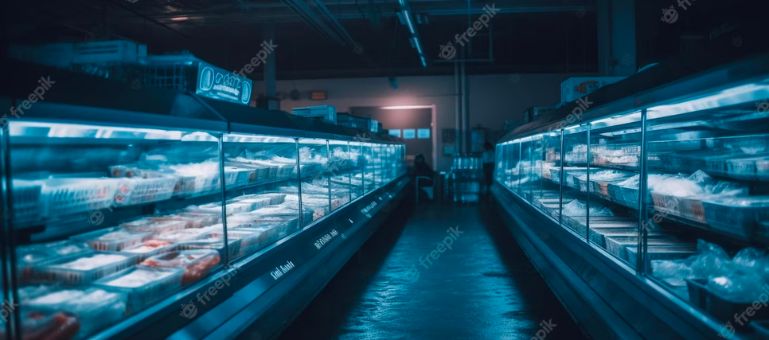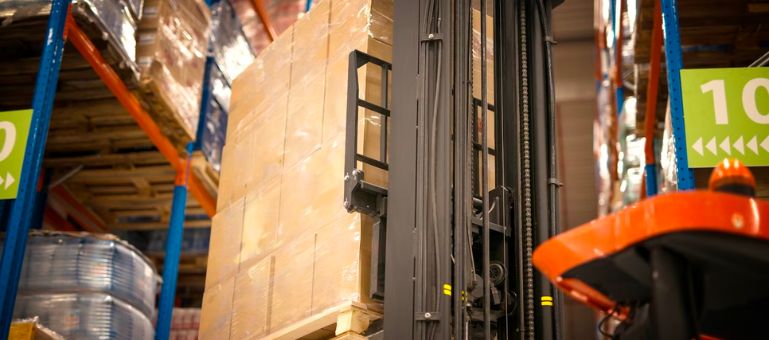There has been a rapid rise in e-commerce retailing in the food and beverage industry. Consequently, the demand for food warehousing and storing logistics has increased drastically.
Food-grade warehousing refers to specialized facilities that store and manage food and beverages. The essential facilities of a food storage facility include regulated temperature control and an efficient food supply chain.
According to a report, the food and beverage warehousing market size is estimated to grow at a CAGR of 18.76% between 2022 and 2027. The market size is forecasted to increase by USD 366.29 billion during this period.
Food-grade warehousing has to meet strict hygiene and handling food products regulations. These laws ensure that food and beverage have an extended shelf life and is safe to consume for customers.
Warehousing should be standardized for efficient inventory management and distribution. However, food-grade warehousing comes with the challenges of overstocking, shortages, or disposing of expired food items.
In this blog, we will explore food warehousing and the functions and benefits of efficient food distribution.
Defining Food Warehousing

A Hub of Storage and Distribution
The term ‘food grade’ describes the materials and equipment that are safe to be used in food storage. Food-grade warehousing is a storage and distribution facility pivotal to efficiently running a food supply chain.
Food warehousing offers storage of perishable and non-perishable items. These range from fresh fruits, vegetables, meat, and dairy products to canned foods and snacks. Such specialized storage areas ensure that each food product receives the optimal conditions.
Food manufacturers trust the warehousing staff to handle food and beverage items properly. This includes using technology and techniques such as using forklifts for stacking. Food warehousing aims to ensure that food products remain in their prime condition.
The end goal of food warehousing is the systematic distribution of stored food products. Delivering food items to consumers, online retailers, or grocery stores requires efficient inventory management by professionals.
Critical Functions of Food Warehousing
Food warehousing works to regulate the food supply chain. It is based on several steps, from receiving the products to sending them out.
Let’s look at each step of food-grade warehousing and see how it ensures optimal product conditions.

The first step in the food-grade warehousing chain is receiving the shipment. This is where the food grade logistics for unloading the shipments come in.
Receiving the shipment requires the logistics team to inspect the condition of the produce, carry out a quality control check, and quantify the products.
The packaging should be intact at delivery with proper documentation. The delivery is handed off with receiving signatures and labels on the stock.
Once the consignment is received, the team is responsible for transporting it and storing it in appropriate places. Delivered items are placed in dry storage, frozen food, or refrigerated areas following the first-in-first-out (FIFO) rule.
The next step, inventory management, determines the efficiency of the food-grade warehouse. This means that the operations team must make an inventory of the stock.
Look for a food warehousing facility that manages inventory using software tracking the inflows and outflows. A food warehouse facility with automated inventory management allows a steady consumer supply.
In cases where retailers or consumers place orders for delivery or pick-up, order fulfillment should be carried out accurately. The staff has to pack the accurate quantity of the shipment of the product. It also requires another round of quality control checks so consumers enjoy a positive experience.

Large-scale food-grade warehouses rely on advanced technology for coordinated operations.
Most used programs include barcode systems, which are scanned to insert or subtract a product from the stock, and RFID tracking to locate the rack of the product.
While all these stages ensure proper management, food warehousing must be registered and follow regulatory guidelines.
Sanitation and pest control keep food warehouses safe from contamination. All rodent entry points are also closed and secured according to a safety plan.
Ensuring Food Quality and Safety
Food warehousing should be practiced at standards that keep products safe for consumption. Here are two significant factors that affect food warehousing and its environment.
Temperature Control and Preservation

It is widely known that each food and beverage item demands an environment that prevents it from going rancid. The factors controlled in a food-grade warehouse include temperature and humidity.
Let’s understand why temperature regulation is of paramount importance.
If food items are not kept at the correct temperature, it allows the rapid growth of harmful contaminants such as bacteria and mold.
One way to slow this down is to keep the food at the designated temperatures. The general guidelines for refrigeration are as follows:
- Dry food: 50°F to 70° F
- Frozen items: below 0°
- Refrigerated chilled items: 34° to 39° F
Cold chain warehouses are used to preserve foods, such as farm fresh agricultural goods, seafood, meat, ready-made frozen food, or pharmaceutical products.
The main components of temperature-regulated warehouses include compressors, condensers, and evaporators. Secure airlock systems that avoid drastic temperature changes are installed to regulate the inside.
This flow of cold air in the storage increases product protection by extending the shelf life of perishable items. It prevents pathogens from destroying the packaging or oxidizing the food content.
Frigid temperatures can be detrimental to the stored food’s nutritious value as high temperatures.
For this purpose, warehouses invest in temperature monitoring alarms that detect deviations in temperature from the desired range.
Similarly, temperature mapping uses sensors for uniform heat or cold across the warehouse. These identify changes in temperature from the baseline.
Dehumidifying is as important as temperature control in the warehouse. Excess humidity can cause moisture to permeate packaging material and ruin the freshness of the produce.
Sensors monitor humidity, and dehumidifiers are used if it affects moisture levels.
Instead of the benefits of temperature regulation on product integrity, the demand for the global cold chain logistics market is growing. It was worth 248.4 billion U.S. dollars in 2020 and is expected to exceed 410 billion U.S. dollars by 2028.
Compliance with Regulations
To be approved by the Food and Drug Authority (FDA), a food-grade warehouse should fulfill several requirements. This registration requires following standard operating procedures and complying with the organization’s ethical culture to receive certifications.
The FDA conducts annual visits and inspections at the warehouse to ensure adherence to the food-grade storage principles.
In addition, the warehouse must have a valid license in compliance with The FDA Food Safety Modernization Act (FSMA). According to this act, the warehouse should have intact hygiene and sanitation practices to minimize the risk of foodborne illnesses.
Additionally, the Food Safety and Inspection Service (FSIS) monitors and evaluates the quality of commercial meat, processed eggs, and poultry products for safe consumption.
This requires the food-grade warehouse to execute a well-planned Food Safety Plan of Action.
Adequate and standardized hygiene practices at the warehouse should be carried out before food handling. Warehouse staff should wear gloves and wash hands repeatedly. This becomes important when handling raw produce, such as fruit and vegetables.
Adopting a sanitization routine for the warehouse is equally essential. The staff should follow the protocol for handling expired products and disposing of them in a way that does not lead to cross-contamination of food allergens.
The regulating authorities pay special attention to routine pest control checks at a food-grade warehouse. This is because dry food items, such as rice, grain, and cereal, are the first to be contaminated particularly.
This requires regular checks to ensure entry points and openings that could allow insects and rodents to be sealed off.
A food safety plan should carry out timely fumigation services in a safe way for the environment. Ensure there are no water leakages that could spoil the stored products.
Similarly, the regulatory body requires the products to follow industry standard guidelines in case of an affected batch. This means that the products should be feasibly traceable amongst the lot.
For this, the staff ensures that each product carries a barcode label, product name, food allergen, ingredients, and nutritional values.
The packaging should carry batch numbers to allow for quick traceability and identification of the lot in case of damage to the product.
Add information regarding the country of origin for consumers to make informed decisions.
Thus, adhering to quality control regulations in food warehousing ensures safe and compliant storage that minimizes food spoilage and loss.
Challenges and Solutions
If you look at food-grade warehousing, it is a complex system that functions on a vast scale. It requires timely management of all procedures to ensure the inflow and outflow of products from the inventory and can be easily prone to inefficiency.
Inventory Management and Rotation

The first and most significant challenge of food-grade warehousing distribution is the complex task of inventory management.
Brands and companies that sign up for food-grade storage change their products and manufacturing. This is done on a seasonal change or with the rapidly changing consumer demands.
A rapid change in the market trends affects the warehouse and how it operates. This is because the warehouse receives trending items with the older stock items still in storage.
Additionally, the food supply chain is disrupted by labor strikes, transportation charges, the cost of raw materials, and in cases of natural disasters.
This disruption in the food supply chain leaves a significant impact on the profit margins of the warehouse.
Since storage, transportation, and supply cannot be carried out at the right time, it hurts the quality of foods. Perishable goods are spoiled and contaminated if not stored correctly.
Moreover, warehouse owners are concerned about perishable items with limited shelf life. The risk of products nearing the expiry dates before being distributed or sold affects the product margins.
Brands are constantly updating packaging options, sizing, and quantities of products.
Adding newer products to the inventory at the warehouse can lead to discrepancies in counting, inventory management, and storage. This can lead to newer packaging products being sold out first.
All of these challenges can result in food and beverage items expiring. Food waste reduction itself is difficult to carry out in food warehousing.
Most of the challenges encountered with inventory management can be avoided if the warehouse staff plans with the food manufacturers beforehand. The overstock problem at the warehouse also requires steady communication with the suppliers.
Food warehousing works on the principle of first-in, first-out (FIFO). Compliance with FIFO is necessary to ensure that older products are sold before newer ones are sent out.
Advanced inventory solutions navigate the challenges in food warehousing by removing manual count errors, data entry mistakes, and discrepancies that can lead to spoilage.
Efficient Space Utilization

Given the nature of operations, expect a food-grade warehouse to always have high stock-keeping units but low storage space.
Food and beverage stocking warehouses seek to improve space utilization and increase storage capacity. Let’s discuss a few ways to make sufficient capacity.
Start with the layout of the warehouse. Study the floor plan and consider utilizing maximum space, including hallways.
Test the feasibility of constructing mezzanine floor platforms. This creates additional levels of storage without horizontally expanding the capacity.
The easiest solution to a storing problem is vertical stacking of products. Place similar packages of products on top of the other. This saves most of the warehouse space and allows you to double the storage capacity.
Vertical stacking is carried out by elevator trays, which deliver and retrieve the items from heights, keeping the warehouse organized. These are operated by staff who can identify the items and direct the elevators.
Adopt a shelving hierarchy in the warehouse. This means placing the high-demand or frequently ordered products and packages within the team’s reach. It makes the space more accessible and avoids using ladders frequently, reducing the retrieval time.
Warehouses invest in racking systems that accommodate various sizes and weights. These include pallet racks, drive-in racks, and pushback racks. These allow forklifts to access products with varying sizes and SKUs directly.
Dynamic flow racks are used for fast-moving consumer goods and work on the FIFO principle.
When the products are loaded onto the higher end of the rack, they push the existing products further down the rack. This ensures that the oldest items are always picked first.
An organized warehouse reduces the need for expanding the infrastructure and allows product storage with the changing consumer trends.
Future Trends in Food Warehousing
Food Warehouse Automation

According to a report by Business Wire, the number of warehouses is rapidly increasing with the e-commerce demand; however, over 80 percent of the warehouses today rely on manual task forces.
So, what is an error-free solution to solve the challenges of food warehousing?
Warehousing is not an easy task. It is time to invest in automated food warehousing if you want to ensure the fulfillment process and the food supply chain do not face discrepancies.
As the term explains, automated warehousing for food and beverages relies on technology to make tasks easier. You can enjoy optimized storage and accurate inventory management with an automated warehousing facility.
The solution to discrepancies in inventory management is ensuring that you balance order fulfillment and procurement. Warehouse management systems use data analysis software that updates the stock products and their placements in real-time.
Moreover, it can predict the forecasted supply based on consumer demand and previous orders. This keeps the volumes of the stock regulated and prevents stock wastage.
The management software works as a logistics facility coordinator. It comes with
quality control features that carry out automated checks at various stages in the supply chain. The findings are reported and reflected on the dashboard.
This allows workers to find and replace items that fail the checks.
Another significant benefit is the automated storage and retrieval systems (AS/RS). These robotic systems not only automate the storage but also retrieve items from specific locations. The machinery follows an established floor plan and route of the warehouse to reach the storage space.
Sustainability and Green Warehousing
Is your storage facility a green warehouse that promises a sustainable future in food warehousing?
Knowing the potential of a food warehouse to generate waste, sustainable practices must be adopted.
Large-scale warehouses that offer cold chain facilities use industrial refrigerators and freezers.
Invest in eco-friendly and energy-efficient solutions for the warehouse to keep energy usage in check. These include renewable energy sources, such as solar panels or wind-powered warehouses.
Invest in energy-efficient LED lighting solutions. The HVAC system should be automatically adjusted depending on the external environment.
Ensure that the food manufacturers and packagers are using eco-friendly materials to make packaging material. This makes it easy to decompose and dispose of spoiled food and beverages, preventing environmental harm.
If your procurement levels align with your production and distribution plans, you can meet your expected sale demands and prevent ingredients from going bad before they can be consumed.
Conclusion
Food warehousing facility benefits food manufacturers by providing a temperature and moisture-regulated environment for transportation and storage.
The essential purpose of a food warehousing facility is to extend the shelf life of products and prevent any physical damage to the packaging. Manufacturers want a warehouse that offers complete facilities to maintain a steady food supply chain for food products.
The food warehouse should comply with state law and the FDA’s safety regulations. This includes timely pest controls and sanitation practices to minimize foodborne illnesses.
Adopt automated food warehousing practices to regulate inventory management. Contribute to the environment positively with sustainable and green warehousing with minimal wastage.
Maximize the benefits of food warehousing with supply chain efficiency to meet the changing consumer demands and market trends.













